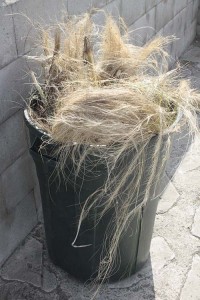This will be the year that I finally win the battle against Mexican feathergrass, the blogger said optimistically. I doubt that I’ll be seeing the end of this beautiful but wildly overprolific grass any time soon, but I’ve completed pulling all the parent plants in the garden. With the source of seeds removed, the hundreds of unwanted seedlings that I have to pull up every year should diminish.
So how bad was the feathergrass problem? Here’s a shot underneath a black sage in the back yard, no closer than seventy-five feet from the nearest adult feathergrass plant capable of setting seed. The seed just blew downwind and set up household in the sheltered germinating conditions in the shade of the sage. Other areas of the garden will look like this when the rains begin again and all the banked seed begins to germinate. I hate to think that these might get to the local urban canyon, four houses away.
My relationship with Mexican feathergrass (Nassella tenuissima or Stipa tenuissima) started off in the early 1990s. Like most people who’ve planted it, I saw it at the nursery with its stalks weaving delicately in its beguiling come-hither way and fell in love. I bought two.
At first things between us went well. The grasses spread a bit, but the thought of free plants were a real bonus. I even gave plants away.
Though prolific, the plant isn’t currently listed as an invasive species on the master Cal-IPA inventory, but appears on a 2007 list of nominated species. It’s clear from some of the comments on a Fresh Dirt posting that it’s a growing problem in some areas, my neighborhood included.
Yes, the stuff is gorgeous. But too high maintenance and potentially problematic in my area. It’s time for us to part ways.
So how will I get my fix for delicate, feathery grasses? This year has been my first time growing the native Aristida purpurea, purple three-awn, a species that’s found locally. The plant is shorter than the common feathergrass, which might be a bonus, depending on your garden situation. And unlike the nassella it has a decidedly purple color to it while it’s growing–very nice. I’ll post photos once my plants get a little bigger. I have no idea if it’ll be the same issue of the plant volunteering all over the garden, though I doubt it. Even if it escapes to the wilds, it’ll be in the company of others of its species. Not a problem.




I’ll be interested to hear if you were successful in divorcing yourself from feathergrass. Always glad to be told about invasive varieties; it’s possible that since grasses are lately “in fashion” there may be more problems waiting down that line.
Amazing as it is to me to witness the survival tactics of plants, and much as I appreciate their ability to create greenery in hostile landscapes, it’s true that there can be too much of a good thing.
Pomona, it’ll be a multi-year effort, I’m sure. Some plants are amazingly well-designed to perpetuate their species, and feathergrass is definitely one of them!
Brad, we have a mega church/school a couple miles away where they did a major landscape makeover that included the planting of dozens of these plants. I used to be sorry for the neighbors because of all the Sunday traffic they must endure, now I’m sorry for them because they’ll be weeding feathergrass the rest of the week.
I too love Mexican feathergrass, but know from my last house how invasive it is. My housemate planted it in the front yard and I found seedlings in the backyard. A lot of seedlings. Unfortunately my city, when planting new street trees and widening the planting areas, put 3 Mexican feathergrass in each strip. I caught the guys and stopped them from doing it in our yard, since I had already planted some natives there, but it’s probably going to be a losing battle.
I still weed it from a garden where someone planted seven years ago and pulled it out two years later. Five years and it still comes up, though not in large numbers. Wicked little plant. Clients request it all the time.
I’ve been enjoying A. purpurea in my garden this year. It took me a while to latch onto the idea of it for various reasons not least of which was that I had misidentified N. pulchra as A. purpurea.
Best wishes for continued eradication. (Which sounds weird to say without the context, doesn’t it?)
Hi james,
I know Mexican feather grass is on the invasives list, and yet it is used widely still. On your visit to Cornerstone Sonoma, I’m sure you saw it in the Van Sweden garden, and it’s still going strong in Pamela Burton’s Earth Walk, to name two!
I’ve grown it over the decade since installing my garden and I’m actually pleased when it pops up here or there. Needless to say, it’s not a problem in my tightly enclosed dry plot.
But the owner of the first private Marin garden I wrote about and photographed for a cover story has mentioned dealing with attempts to remove it.
His garden in on San Pablo Bay, the perfect sandy soil for this grass to colonize. He worked with John Greenlee when designing the garden, so such a lovely grass – looked upon as so very desirable, like so many invasives, must now be fought on a daily basis to eradicate.
I send warm wishes you way for Turkey Day!
Ah yes, I inherited some from the previous owner, but ripped it out last fall and seem to not have too much trouble with seedlings. (One of the native grasses, on the other hand, loves clay and is harder to keep under control…)